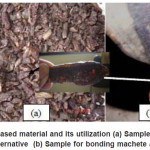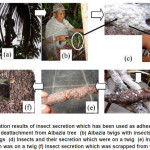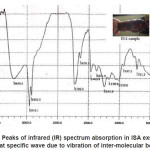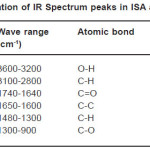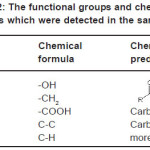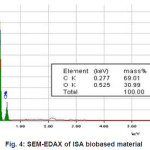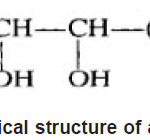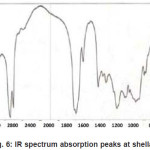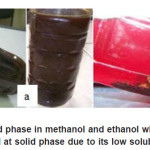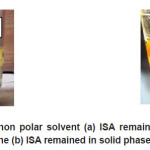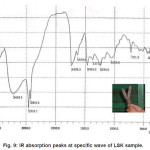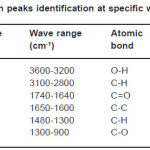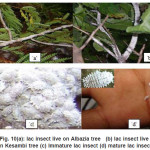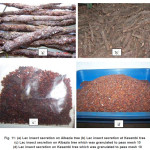Investigation and Characterization of Insect Secretion on Albazia Tree as Biobased Material Alternative for Matrix Composite
Introduction
Persistence of plastics in the environment, the shortage of landfill space, the depletion of petroleum resources, concerns over emissions during incineration, and entrapment by and ingestion of packaging plastics by fish, fowl and animals have spurred efforts to develop biodegradable or biobased plastics.1 Biocomposites have been the subject of international research since at least the mid-1990s and a number of practical applications are now emerging, including interior automotive components and housings for notebook computers. Commercial interest in manufacturing these products is driven by the derivation of the biobased material from renewable sources as well as by their specific properties including biodegradability.² Wastes from plastics have become a worldwide environmental problem, not only in developed countries but also in developing countries. Production of biodegradable biobased material is now widely expected to contribute to the solution of the problem, since biodegradable biobased material would enter the material cycles in the environment.³
In Indonesia, precisely in the area of Ciamis regency, West Java District, some people have been using biobased material to patch the roof, to join rod of machete and rod of hoe. They call it with the term “ant’s house”. Analysis of these facts provides three important informations related to alternative biobased materials. First, biobased material has good adhesive properties of being able to joint the hoe stem and a machete rod. Second, the polymer has a sufficient availability with ease indicators obtained in traditional markets, Jabar Ciamis district. Third, the polymer is derived from the renewable sources because they call it with the term “ant’s house “. Therefore, the investigation and characterization of the biobased material is needed to know the main sources and its chemical structure composition.
Investigations were conducted in the traditional markets Ciganjeng and Padaheurang, Ciamis, West Java to obtain samples of biobased materials. While the collection of information related to the location of main sources of the biobased material were carried out through interviews with people around. The objective of this research was investigation and characterization of insect secretion on albazia tree as biobased material alternative for matrix composite.
Materials and Methods
The sample comes from biobased material used by the people Ciamis regency, district of West Java, Indonesia as an adhesive material. Investigation and characterization were conducted to ensure the main source of the sample and determine the chemical structure of it, respectively, in order to find an alternative biobased material. Therefore, the sample can be engineered into a natural matrix composite.
Investigation for Ensuring Main Source of the Sample
Investigation through collecting and finding out informations related to the main source of sample was conducted in 3 traditional markets: Ciganjeng and Padaheurang traditional market at Padaheurang subdistrict and Banjarsari traditional market at Banjarsari subdistrict, Ciamis regency, district of West Java, Indonesia.
Characterization for Determining the Samples’ Chemical Structures
The Fourier Transform Infrared (FTIR) Test was conducted at room temperature of 20°C and humidity of 60% by FTIR Shimadzu Seri 8400S with beam splitter of KBr wrapped Germanium plat. By FTIR, functional groups of sample could be known in order to predict its chemical structure.
Elements Mass Measurement of Sample
The sample was coated with gold by sputtering process and then analyzed using a JEOL SEM-EDAX Model J6360LA. Elements mass of sample were measured with EDAX processing in order to predict its chemical structure.
Polarity Test of Sample
Polarity test of sample was done to prove polarity of the chemical structure prediction through mixing it with water (polar material), alcohol (semi-polar material) and gasoline, kerosene, aceton (non polar materials)
Visualization of Sample
Test Visualization of investigation results by photographs was done to validate biobased material and renewable resource of the sample.
Result and Discussion
Initial investigation showed the fact that some people in Ciamis, have been using the sample (Figure 1a) as an adhesive material such as for patching a leaky tin roof, bonding hoe with its rod, machete with its stems as shown Figure 1b. The sample which is usually called “Imah sireum” or “house ants” can be obtained in traditional markets, such as Ciganjeng, Padaheurang, and Banjarsari traditional market at Ciamis district. Figure 1. Biobased material and its utilization (a) Sample of biobased material alternative (b) Sample for bonding machete and its stem
Figure 1: Biobased material and its utilization (a) Sample of biobased material alternative (b) Sample for bonding machete and its stem
Further investigation was performed to determine the main source of biobased material with a trace of remote and rural mountain areas of village of Karangnangka, subdistrict of Banjarsari, Ciamis regency, West Java. The investigation results showed that the sample comes from the secretion of insects that live in Albazia trees (Albazia falcataria sp.) as shown in Figure 2. To simplify the writing, hereinafter, this biobased material will be written ISA (Insect Secretion on Albazian tree) sample. The insects cause tree branches to be dried (Fig 2 c-d) but do not die the trees (Fig 2a-b). This is evidenced by the discovery of ISA on the not-dying large trees eventhough their twigs which are used as the colony becomes dry.
Figure 2: Investigation results of insect secretion which has been used as adhesive bonding (a) Insect secretion deattachment from Albazia tree (b) Albazia twigs with insects (c) Insects live on Albazia twigs (d) Insects and their secretion which were on a twig (e) Insect secretion which was on a twig (f) Insect secretion which was scrapped from twigs
Characterization of ISA by FTIR
Initial characterization of ISA was done by FTIR to know the functional groups content in it that built its chemical structure. Peaks of infrared (IR) spectrum absorption in ISA exsisted only at specific wave due to vibration of inter-molecular bonds, as shown by Figure 3. Identification of each peak was conducted by entering them to wave range indicated identity of each atomic bond as shown by Table 1. These atomic bonds built functional groups which form chemical structure of sample.
Figure 3: Peaks of infrared (IR) spectrum absorption in ISA exsisted only at specific wave due to vibration of inter-molecular bonds
Table 1: Identification of IR Spectrum peaks in ISA at specific wave
Wave number of 1726 cm-1 and 3429 cm–1 showed energy absorption of carbonyl C=O and hydroxyl O-H functional group, respectively, that enable to form carboxylate (-COOH). O-H functional group for carboxylate was usually detected at 2500-3400 cm-1 [4], but for this sample, it appeared at 3429 cm-1 due to the OH overtones of alcohol that is about 3500 cm-1. This was supported by the absorption of energy that produced the wave numbers of 1245, 1168, 1010 and 937 cm-1 which indicated that there were 4 CO functional groups, and allowed binding to OH group. In this sample the wave numbers of 721 cm-1 was also found that indicated more than 4 Carbon chain built the chemical structure of sample, because the CH2 rocking with wave numbers 720-730 cm-1 occured in the chain C is greater than 4 [4].
C=O functional group at this sample did not come from aldehyde due to the absence of C-H at about 3000 cm-1 eventhough C-H aliphatic in methylene (-CH2) was detected at 2918 cm-1 (asymmetric) and 2858 cm-1 (symmetric). This is in line with [5] who stated that the CH stretching in a single methylene usually occurs around 2853 cm-1 (symmetric) and 2926 cm-1 (asymmetric). The sample did not have 2 small bands: 2962 and 2872 cm-1 so that there was not methyl group (-CH3). It did not also have the aromatic C-H due to no indication of very strong wave numbers in at 3100-3000 cm-1 [4]. This is also in line with Hardjono [5] who stated that the C-H stretching aromatic and alkene occurs above 3000 cm-1, whereas the C-H alkane under 3000 cm-1. The Sample also have CH2 scissoring with wave number indication of 1463 cm–1 because CH2 scissoring usually occurs in the wave numbers 1465 cm-1 [4].
Based on data analysis of the FTIR results, the functional groups contained in the sample are presented in Table 2.
Table 2: The functional groups and chemical bonds which were detected in the sample
Atom Weight of ISA Biobased Material
The results of SEM-EDAX to the sample, C and O atoms with mass ratio 69% for C and 31% for O were detected, as shown in Figure 4. Actual sample atoms consisted of H, C and O, however, H atoms are too light to be able to detect so that the atomic weight of C and O only which had been recorded. Base on the periodic table, the mass of C and O atom are respectively 12 and 16 while the total mass ratio of C and O atoms that make up the atoms are too light to be able to detect so that the atomic weight of C and O only which had been recorded. Base on the periodic table, the mass of C and O atom are respectively 12 and 16 while the total mass ratio of C and O atoms that make up the
12 C : 16 O = 69 :31 → C= 2,94 × O→ C H ≈ 3 x O
Figure 4: SEM-EDAX of ISA biobased material
The number of C atoms that built ISA is about 3 times more than O atoms, so that it can be used roughly as a chemical structure prediction. If the O atoms amounts 5, the C atom amounts 15, however the SEM-EDAX data has an error tolerance of about 4%, consequently, it is still possible for the C atoms to get amount of 14 or 16. These results are helpful in predicting the chemical structure of ISA biobased material by eliminate chemical structures that have a ratio of C and O atoms greater than 3:1.
Langenheim5 classify natural polymers from renewable sources into several groups of resins (eg, resin), gum (eg gum arabic), Mucilage (for example gelatin), waxes (eg, night), fat (oil) and latex. Natural biobased material belonging to the group of resins has a chemical composition of terpenoids, or phenol, gum and Mucilage is composed by polysacharida, wax composed by esteryfied fatty acids, fats or oils composed of fatty acids and glycerol, while the latex is a complex compound of terpenoids, phenols, proteins, etc.
Terpenoid is a complex compound with isopentane as a basic constituent with methil group (-CH3), while a phenol has an aromatic benzene group. ISA sample are not resin because they do not have methil group (-CH3) and benzene. Polysacharida is sacharida polymer composed of the glyceraldehyde with aldehyde group (-CHO) as one of its functional groups. ISA sample are not gum and mucilage gum because they are built functional groups rather than aldehyde. While wax has a fatty acid compound that is composed by one of methil functional groups (-CH3) and esters. ISA sample is not part of wax and latex. Groups of biobased material with carboxylic groups can compose many type of carboxylic acids.
One of the carboxylic acid belongs to C atom about three times the O atom and present all the functional groups detected in the sample is an aleuretic acid as shown in Figure 5. This acid has functional groups (-OH), (-CH2), (-COOH) and the chemical bonds (C-C), (C-H) and (C-O) which are all detected in the sample. So the preliminary conclusion is ISA sample is composed of aleuretic acid.
Figure 5: Chemical structure of aleuretic acid
Examination of ISA Chemical Structure
According to Brydson,6 aleuretic acid is the main constituent of shellac. Therefore, the validation of the prediction that aleuretic acid is the main constituent of ISA polymer can be proved by comparing FTIR results of ISA polymer as shown Figure 2 to FTIR of shellac from Gatty Conservation Institute7 a shown Figure 6. Detection wave ranges (cm-1) in Figure 6 were 3600-3200 (O-H stretching band), 3100-2800 (C-H stretching band), 1740-1640 (C=O stretching band), 1650-1600 (C-C Stretching band), 1480-1300 (C-H bending bands), 1300-900 (C-O stretching bands). Both of the FTIR result in similar absorption. It indicates that both sampel composed of the same functional groups.
Figure 6: IR spectrum absorption peaks at shellac
Polarity of ISA Biobased Material
Second examination to prove that the main content of ISA sample is aleuretic acid was done by dissolving method in which polar substances dissolve in polar solvents and insoluble in non-polar. A -COOH functional group is polar, but the long alkyl chain in the aleuretic acid causes this material to be semi-polar. The great amount of hydroxyl group content causes the sample to be soluble in alcohol (Figure 7a). Solubility in water is very low because it has a long alkyl chain that is 16 as shown in the Figure 7b. Bodner [9] revealed that the carboxilic acid solubility have decreasing levels in the water along with increasing amounts of alkyl chain. Long alkyl chain is non-polar, however, the – COOH group at the end of the molecule is polar so that the carboxilic acid will dissolve in water eventhough only slightly and the water color changed to be reddish but ISA remains in solid phase.
Figure 7: (a) ISA changed to liquid phase in methanol and ethanol which are semipolar solvent (b) ISA remained at solid phase due to its low solubility in water
Hypothesis that chemical structure of the sample was proven right by the unsolubility in non-polar hydrocarbons such as gasoline and kerosene as shown by Figure 8a. This sample does not include cetones, due to no evidence of solubility in aceton as shown by Figure 8b. This related to the presence of wave number of around 1700 cm-1 which is C = O carbonyl group which allows cetone group (RCOR).
Figure 8: ISA did not dissolve in non polar solvent (a) ISA remained in solid phase due to its no solubility in gasoline and kerosene (b) ISA remained in solid phase due to its no solubility in aceton
Proving of ISA Chemical Structure Prediction by Comparing to Raw Material of Shellac
If ISA and shellac biobased material composed of the same chemical structure, then logically ISA and shellac basic material biobased material also composed of the same chemical structure. Therefore, studies related to the shellac basic are nessesary. According to Singh,10 the lac treatment process comprise of stick lac, seedlac and shellac. Stick lac is lac which still attached to the parent branch. Seedlac is the further process of the lac stick into granules which passed mesh10 so as not to clot and prevent the breeding of pests in the storage room. While shellac is the end product of the lac processing. According to Chauhan,11 lac is resin shaped secretion produced by the soft body lac louse to protect the unfavorable environment and attached to the parent branch. In summary, it can be concluded that the shellac comes from the lac bug secretions in the form of resin. Shellac is made from raw materials originating from lac louse secretion, whereas ISA sample has chemical structure similarity with shellac. Therefore, ISA sample functional group should be equal to that of lac secretion as basic materials makers of shellac. To prove this conclusion, characterization and investigation of lac secretion that has been produced in Indonesia is needed. The results of investigation showed that the insect that produce secretion for shellac basic materials have been cultivated at Kesambi tree by PT. Banyukerto, Probolinggo under PT. National Plantation II (PTPN II) of East Java.12 To simplify the writing, the lac secretion of Kesambi tree is hereinafter referred to as LSK.
LSK characterization by FTIR can reveal that the compilers of its functional groups are the same as that of ISA, ie (-OH), (-CH2), (-COOH) and (C-C), (C-H) and (C-O) as shown by Figure 9 and Table 3 . ISA and LSK have the same chemical structure. LSK is the secretion of lac insect that live in trees Kesambi, and ISA sample is a secretion of lac insect that
Figure 9: IR absorption peaks at specific wave of LSK sample.
Table 3: IR absorption peaks identification at specific wave of LSK sample
The Visually Similarity Examination of ISA and LSK
Conclusion that the ISA is the secretion of lac insect live on Albazia tree, has been supported by visual comparison between LSK and ISA samples -related to types of insect, secretion attached to twigs and seedlac products. Basically both insect that appear in the Figure 10 are the same. Insect which are found on the Albazia tree is immature fleas that are still in their colony as shown in the Figure 10c. When getting mature, these insect will run and leave the colony as shown in the Figure 10d
Figure 10: (a) lac insect live on Albazia tree (b) lac insect live on Kesambi tree (c) Immature lac insect (d) mature lac insect
Secretion insect attached to the Albazia and Kesambi trees have form and color in common, as seen in the Figure 11a and 11b. The similarity of the two secretions was also supported by the same visible apparition when the grains are made to pass mesh 10 as shown by Figure 11c. and Figure 11d.
Figure 11: (a) Lac insect secretion on Albazia tree (b) Lac insect secretion at Kesambi tree (c) Lac insect secretion on Albazia tree which was granulated to pass mesh 10 (d) Lac insect secretion on Kesambi tree which was granulated to pass mesh 10
Implication Of Research Results
Lac insect can live on Albazia tree without treatment and do not cause the death of the parent tree. This conclusion is supported by the fact that the lac insect secretion were used by community obtained from Albazia trees grown and live wildly in a rural mountain area of Karangnangka village, Banjarsari subdistrict, Ciamis regency, West Java District, Indonesia. The results of the investigation and characterization may have implications for the potency for cultivation of lac insect at Albazia trees. Albazia trees have in nature easy planting and maintenance, relatively short age, and versatile wood so that many people who planted them both in the yards and other vacant lands. If lac insect cultivation ways can be developed on Albazia tree, then the added advantage can be gained as lac insect secretion attached on it branches. These branches will dry, but the Albazia trees do not die so that timber harvest can still be done.
Conclusions
Based on data and discussions of ISA sample, including: functional groups, the similarity in the wave range of energy absorption between the ISA sample, shellac and LSK, the solubility in polar solvents and the insolubility in non-polar solvents, the similar insect visualization, insect secretion visualization both before and after granulated, the conclusion can be drawn as the following:
Insect which live on Albazia trees are lac insect.
ISA sample that has been used by the surrounding community as an ingredient for adhesive is the secretion of lac insect that live on Albazia trees.
The term “imah sireum” or” ants house “ used by Ciamis community refers to this biobased material is not appropriate. So, ISA sample is not “ant’s house” but lac secretion and one of alternative biobased materials for matrix composite application development.
Lac insect can live on Albazia tree without treatment and do not cause the death of the parent tree.
Acknowledgements
The research was funded by DIKTI program of BPPS Scholarship and Doctoral Grant, Ministry of National Education, Republic of Indonesia. The authors gratefully give thanks to Gadjah Mada University and Yogyakarta State University for laboratorium, and PT. Perkebunan Nusantara II for secretion of lac insect on kesambi for comparison sample.
References
- Mohanty, A.K., Misra, M., Dzral, L.T., Selke, S.E., Harte, B.R. and Hinrichsen, G., Natural Fibers, Biobiobased material And Biocomposite: An Introduction, Chapter 1, CRC Press, Taylor and Francis Group, 6000 Broken Sound Parkway NW, USA (2005).
- Plackett, D., Vazquz, A., Natural polymer source, Chapter 7 in Green Composites. Polymer composites and the environment edited by Caroline Baillie, Woodhead Publishing Limited, Abington Cambridge CB1 6AH, England, pp. 123-153 (2004).
- Kazuo Kitagawa, Umaru S. Ishiaku, Machiko Mizoguchi, and Hiroyuki Hamada., BambooBased Ecocomposites and Their Potential Applications, Chapter 11 in Natural Fibers, Biobiobased material, and biocomposite, by Mohanty, A.K., Misra, M., Dzral, L.T., CRC Press, Taylor and Francis Group, 6000 Broken Sound Parkway NW, USA (2005).
- Derrick, M.R., Stulik, D., James, M., Scientific Tools for Conservation. Infrared Spectroscopy in Conservation Science, Getty Trust All rights reserved, The Getty Conservation Institute, Los Angeles, USA, pp. 82-128 (1999).
- Harjono Sastrohamidjojo., Spektometri Infra Merah, Liberty Yogyakarta, Indonesia, pp. 45100 (2007).
- Langenheim, J.H., Plant Resins: Chemistry, Evolution, Ecology, and Ethnobotany, Timber Press Inc, Portland, Oregon 97204, USA, pp. 23-50 (2003).
- Brydason, J.A, Miscellaneous Plastics Materials, Chapter 30 in Plastic Materials, Butterworth-Heinemann Publisher, Oxford OX2 8DP, 225 Wildwood Avenue, pp. 853873 (2003).
- Derrick, M.R., Stulik, D., James, M., Scientific Tools for Conservation. Infrared Spectroscopy in Conservation Science, Getty Trust All rights reserved, The Getty Conservation Institute, Los Angeles, USA, pp. 172-200 (1999).
- Bodner, G.M., The Carbonyl Group, College of Science Chemical Education Devision Group, Purdue University, West Lafayette, Indiana, USA. access date 12/25/2009 8:09:20 (2004).
- Singh, R., Applied Zoology Lac Culture, National Science Digital Library at NISCAIR, India. Httppnsdl. Niscair.res.inbitstream 1234567891 access date 12/21/2006 4:07:18 (2006).
- Chauhan, N. S., Gene Expression and Transmission in kerria Lacca (Kerr), J. Heredity vol. 38 (2), 1977, pp 155-159 (1977).
- Ambahono, T.T., Pengelolaan Tanaman Inang Kesambi dan Kutu Lak dan Pengolahan Lak Cabang Menjadi Seedlak, Perum Perhutani KPH Probolinggo, Jawa Timur, Indonesia, pp. 38-42 (2004).

This work is licensed under a Creative Commons Attribution 4.0 International License.
 Material Science Research India An International Peer Reviewed Research Journal
Material Science Research India An International Peer Reviewed Research Journal

